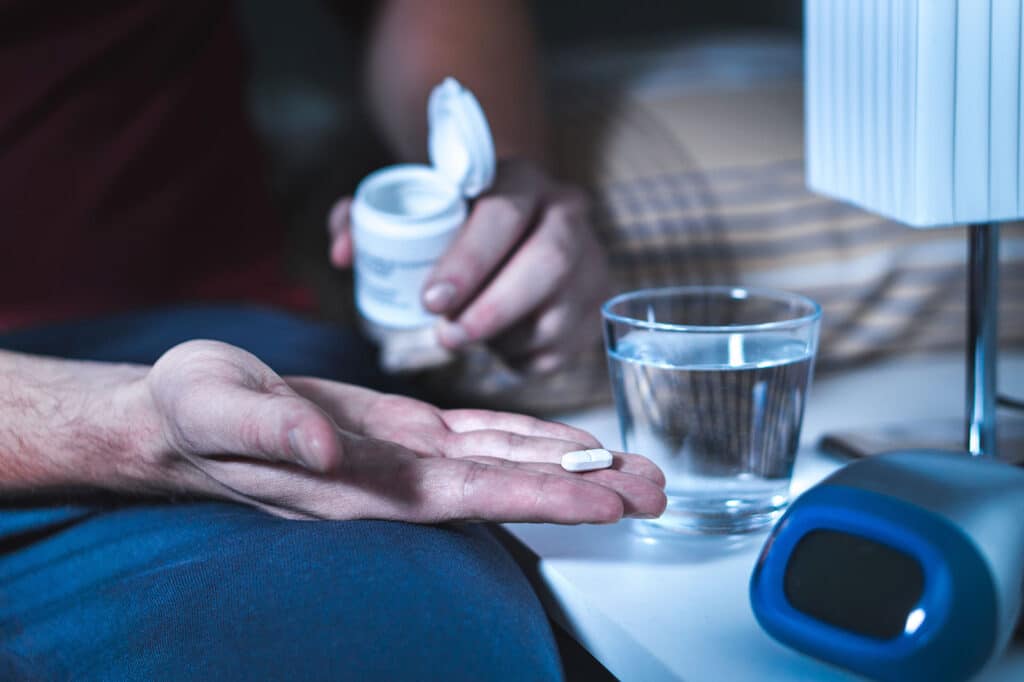The L484 pill contains acetaminophen and is an extra-strength medication. Each pill has 500 mg of acetaminophen. The Kroger Company most commonly manufactures the pill with the L484 stamp.[1] However, many other companies sell acetaminophen. Although people can buy it without a prescription, some doctors may prescribe it for various reasons. Those will be discussed more in a later section. Since acetaminophen is an over-the-counter medication, many people assume that it is completely safe. However, there can be some risks for certain people. Overdose and long-term use also create risks. This guide explains more about the active ingredient in the L484 pill and covers some common concerns.
Table of Contents
L484 Pill Identification

In addition to its identification stamp, the pill has some other distinct characteristics. It is white and has an oblong shape.[1] Most manufacturers who make extra-strength acetaminophen pills use the same design. There are other types of acetaminophen medications as well. Children’s chewable tablets, effervescent tablets, and extended-release pills are a few examples.[2]
About the Active Ingredient
Acetaminophen is often sold under the brands Tylenol and Panadol. Most other companies sell it under its generic name. Outside the United States and Japan, acetaminophen’s generic name is paracetamol.[3]
History of Acetaminophen
Acetaminophen was discovered by accident by a researcher who was trying to find a treatment for intestinal worms.[3] After receiving the wrong chemical, the researcher found that it reduced fever. However, it did not treat intestinal worms. The chemical the researcher received was acetanilide, which comes from coal tar. Acetaminophen was later derived from it. Several other medicines, dyes and substances come from coal tar as well.
Although acetaminophen was synthesized in 1878, it was not used to treat fever and pain until 1893.[3] Acetaminophen became popular in the 1950s after a Tylenol elixir for children was released. At the time, it was a prescription medication that competed with aspirin.
How Acetaminophen Works
Since acetanilide comes with side effects, acetaminophen was created as a safer alternative.[3] While certain mechanisms of its actions are unknown, it inhibits activity in the cyclooxygenase pathway. However, it does not inhibit activity in surrounding tissues.[4] This means that it will not treat inflammation. While it is often categorized with NSAIDs for pain management, it lacks their anti-inflammatory properties. Acetaminophen’s effects on the COX pathway may inhibit prostaglandin synthesis.[4] Ultimately, it produces antipyretic and analgesic effects. Other studies show additional theories of how acetaminophen may affect the body and reduce pain.
Dosage and Administration
Each package of acetaminophen contains dosing information. Since there are products designed specifically for kids, it is better to use those for young children. There are also products for infants. People who use over-the-counter acetaminophen should read the instructions and follow them precisely. Taking it incorrectly can lead to negative side effects or serious issues. Anyone who is considering taking it for the first time should also be aware of who should not take acetaminophen. This will be discussed in an upcoming section.

Unless a physician recommends a different dose, adults and children should follow the package’s instructions. For extra-strength acetaminophen, the recommended dose is usually two tablets for adults or children over the age of 12.[5] Children who are younger than 12 should not take this high of a dose. Other people who should not take acetaminophen will be discussed in an upcoming section.
Uses of the L484 Pill
This drug is used to reduce fevers that occur from viruses or temporary illnesses. People who have fevers that persist for more than a few days should consult a physician. Also, those who have fevers that come with other severe symptoms should seek emergency medical care. Acetaminophen may help treat pain from mild issues like headaches or virus-related body aches. It may also help reduce pain from menstrual cramps, backaches, toothaches or osteoarthritis.[2] Unless a doctor recommends otherwise, do not take acetaminophen for more than 10 days for pain.[2]
In some cases, acetaminophen may be combined with other medications or substances. For example, there are tension headache medications that include acetaminophen and caffeine. Acetaminophen is sometimes included in medications that treat multiple cold or flu symptoms. Additionally, it may be added to medications for sleeplessness or allergies.[6]
Acetaminophen Side Effects
Most people do not experience side effects when they use acetaminophen as directed. Even fewer people experience serious side effects.[7]
Common Side Effects
When people do experience side effects, these are the most common ones:
- Itching
- Stomach pain
- Constipation
- Vomiting
- Headaches
- Agitation
- Insomnia
For vomiting or agitation, contact a doctor immediately.[7] Contact a doctor after 24 hours if any of the other common side effects persist.
Severe Side Effects
Severe side effects are rare. These are some potential severe side effects:
- Fever
- Allergic reaction
- Jaundice
- Blood in the stool with fever
- Peeling skin
- Blistering skin
If any of these symptoms appear, seek immediate medical attention. Acute liver damage and severe skin reactions can be dangerous.[7]
Accidental Overdose Guidance
In some cases, a person may accidentally take an extra dose or take the medication more frequently than recommended. Clamminess, vomiting, loss of appetite and unusual fatigue are early overdose symptoms.[7] If left untreated, an overdose may lead to liver damage or failure for some people. As soon as the early symptoms appear, discontinue acetaminophen use. For a suspected overdose, contact Poison Control by calling 800-222-1222. Seek immediate medical attention for a known overdose.

Acetaminophen Interactions
It is possible for acetaminophen to interact with some other over-the-counter medications. The substance interacts with alcohol as well. Also, there are some disease interactions.
Drug Interactions
There are more than 100 known drug interactions.[8] Some are minor. More than 70 of the drug interactions are moderate. However, several are severe. These are the drugs that can cause severe interactions:
- Leflunomide
- Ethanol
- Levoketoconazole
- Ketoconazole
- Mipomersen
- Lomitapide
- Teriflunomide
- Pexidartinib
Always check if any current medications interact with acetaminophen before taking it.
Disease and Alcohol Interactions
Acetaminophen can have negative effects on people with liver disease or alcoholism.[8] Since some acetaminophen products contain aspartame, they can be harmful to those with phenylketonuria.[9] It is unsafe to combine alcohol with acetaminophen. It may cause serious side effects that damage the liver.[8] Anyone who takes the drug for more than several days to manage pain should avoid alcohol use.
Acetaminophen Precautions
Pregnant or breastfeeding women should ask a doctor before taking acetaminophen or any product that contains it as a secondary ingredient. It is also important for pregnant or breastfeeding women to ask a physician before taking other over-the-counter medications.

Importance of Reading the Label
Each acetaminophen product’s label contains valuable information about ingredients, dosing and precautions. Also, it includes the expiration date. If the medication has expired, buy a new package. There is also information about the manufacturer. Most packages contain information about what to do in case of an overdose. Be sure to avoid using any other drugs with acetaminophen when taking an extra-strength dose. For example, avoid an accidental overdose by not taking it with a cold medication that already contains acetaminophen.
Monitoring for Signs of Allergic Reactions
Allergic reactions can occur in some people. Common signs include a rash, blisters or skin redness.[5] If any of these signs appear after taking acetaminophen, stop taking it. Seek immediate medical help. When a child takes acetaminophen for the first time, it is especially important to monitor for allergic reaction signs.
Safe Storage and Disposal
For optimal results, keep acetaminophen packages in a dark and dry place. Cabinets are usually ideal. Store the medication at room temperature.[5] Do not keep acetaminophen in a refrigerator. Humidity, cold and heat may impact the effectiveness of the medication. To dispose of expired or unused acetaminophen, put it in a plastic bag with an undesirable substance. Used litter and bathroom trash are a couple examples. Dispose of it with regular waste that will be taken to a regulated disposal site.[10] This method helps prevent potential harm from misuse or harm to the environment.
Learn More About Medication Safety
Always consult with a doctor before taking any new OTC medication, and take prescribed substances as directed. Ask a medical professional about any concerns related to the L484 pill or other types of acetaminophen products. For treatment information about any form of substance misuse, please contact us. At the Illinois Recovery Center, we help people establish healthy habits and learn strategies to overcome addiction. We provide a safe, supportive environment for anyone who is struggling with substance use.
References
[1] https://www.drugs.com/imprints/l484-10944.html
[2] https://www.webmd.com/drugs/2/drug-362/acetaminophen-oral/details
[3] https://medicine.tufts.edu/news-events/news/how-does-acetaminophen-work
[4] https://www.ncbi.nlm.nih.gov/books/NBK482369/
[5] https://dailymed.nlm.nih.gov/dailymed/fda/fdaDrugXsl.cfm?setid=2651bf11-4d66-43ba-e054-00144ff88e88&type=display
[6] https://www.fda.gov/drugs/information-drug-class/acetaminophen
[7] https://www.drugwatch.com/drugs/acetaminophen/side-effects/
[8] https://www.drugs.com/drug-interactions/acetaminophen.html
[9] https://www.mayoclinic.org/drugs-supplements/acetaminophen-oral-route-rectal-route/before-using/drg-20068480
[10] https://www.pfizer.com/news/articles/how_to_dispose_of_unused_medicine_responsibly_to_protect_the_environment



